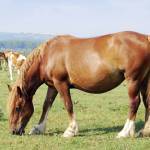Gestation in Mares: What Is Premature? What Is Overdue?

Foaling season triggers considerable hand-wringing among mare owners. The anxiety may be due, in part, to a misunderstanding of what constitutes normal gestation length in mares.
Unlike many other mammals, mares do not have a well-defined gestation period. Oh, how many mare owners wish their charges were as predictable as sows with their nearly foolproof pregnancy length? More than 94% of sows give birth between 114 and 118 days after breeding.1 Cheers for consistency!
For horse breeds, alas, gestational periods of mares are far more variable, with anywhere between 320 and 370 days completely within normal limits. Some experts extend this range further, indicating a 380-day gestation could be considered normal.2
Multiple studies have evaluated gestation lengths in mare herds. One study examined the gestation lengths of Standardbred mares at two commercial farms over a two-year period. Of the 594 foals resulting from these records, the mean gestation length was 349 days. Further examination of data revealed a mean of 347 days for fillies and 350 days for colts.3
The terminology “premature” and “dysmature” are often thought of as synonymous in animal husbandry. They are not. Premature foals are those that are born too early based on gestational length. Dysmature foals are full-term but have physical characteristics of premature foals. In both cases, foals may have silky hair coats, curled ears, small bodies, domed heads, and lax tendons. Because bones within the knees and hocks may not have calcified normally, these foals are predisposed to limb deformities.
How early is too early?
Foals born before the 300-day mark to healthy mares rarely survive, in part because surfactants, which assist with development of the respiratory system, do not work as they do in women. Mares with a problem, such as placentitis, may have an abbreviated gestation that ends in a viable foal, as elevated cortisol can hasten fetal development and better prepare it for survival.
Those foals born between 300 and 320 days frequently require neonatal intensive care, usually in a veterinary hospital, but high-quality nursing often sees these foals through.
Foals born after 370 days of gestation generally do not present a problem, and some are smaller than expected, having been the result of delayed uterine development.
Prolonged gestation may be caused by endophyte-infected fescue toxicity, which is common in certain areas of the country when mares are grazed on fescue pasture or fed fescue hay. Fescue should be removed from the diet two to three months before the due date. Fescue toxicity may prolong gestation but it also have other effects, such as a thickened placenta and reduced milk production. Milk production can be induced through the use of domperidone, a medication known as a dopamine antagonist, beginning 10-15 days before the expected due date.4
Mare owners sometimes ask about inducing labor in overdue mares. Unless the mare is in danger, most veterinarians will not induce labor, as the likelihood of foaling problems escalates, and foal health is usually compromised to the point that intervention by trained critical care veterinarians and support technicians would be necessary for its survival.
The nutritional management of foaling mares revolves largely around the provision of an energy-dense diet that includes a complete complement of vitamins and nutrients. In addition to a base diet of good-quality forage and fortified concentrate, nutritional supplementation can help certain mares. For instance, feeding marine-derived omega-3s can help mares on multiple fronts, as they help bolster immune function, improve colostrum quality, enhance passive transfer of antibodies, and increase fertility rates.
*Ketchem, R., and M. Rix. 2014. Gestation length and inducing: What do we know? National Hog Farmer. (Accessed 4 March 2020.)
2Espy, B. Equine Reproduction from conception to birth. American Association of Equine Practitioners. (Accessed 5 March 2020.)
3Dicken, M., E.K. Gee, C.W. Rogers, and I.G. Mayhew. 2012. Gestation length and occurrence of daytime foaling of Standardbred mares on two stud farms in New Zealand. New Zealand Veterinary Journal 60:42-46.
4McCue, P.M. 2009. Domperidone. Colorado State University.








